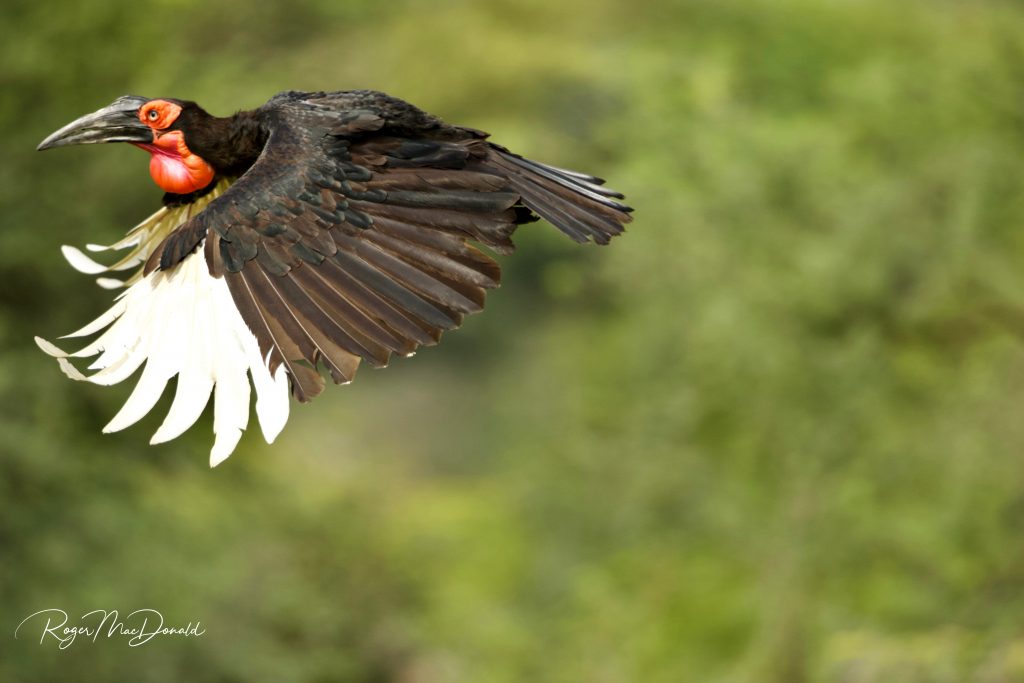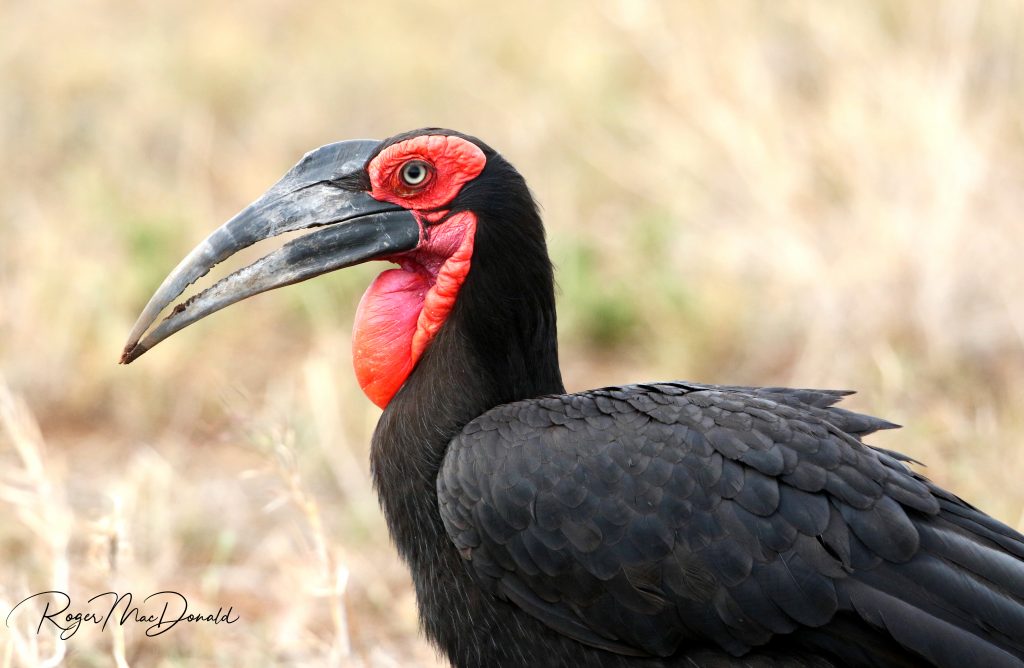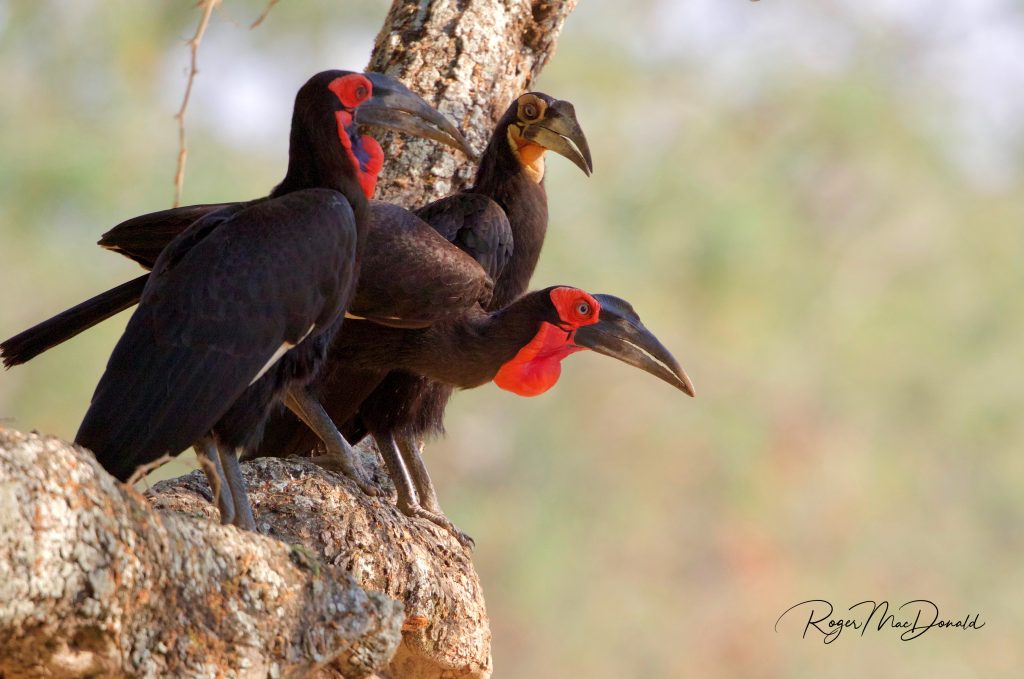Words Evans Mabiza
Images Roger MacDonald and Evans Mabiza
This is a story of a love affair dating 11 years back.

A love affair, not just of the majestic hills that punctuate the Matobo, nor is it of the cultural and historical richness of the hills that showcase Zimbabwe in its natural splendour. It is a story of a bird whose deep booming call resonates through the majestic hills signifying the break of a new day. The drumbeat of Africa. The onset of the rains, a cold spell nearing but sadly, a call increasingly becoming a desperate call for survival.
Commonly known as Ihundundu in Matobo, owing to its deep call, the Southern ground hornbill Bucorvus leadbeateri is in swift decline and this is quantified in areas where populations are closely monitored with the species now meeting the IUCN criteria for being regionally endangered for both South Africa and Namibia.
It is classified as Vulnerable in the Southern African Red Data Book and is also listed on the IUCN Red List of Threatened Species, as Vulnerable with a decreasing population. A global down listing from its previous status of “Least Concern”.
Bucorvus means ‘large crow-like’ bird and leadbeateri comes from Benjamin Leadbeater, a Victorian naturalist from London.
Being a biological hotspot, Matobo offers a diversity of wildlife with some of the most charismatic creatures. For me, the story began with a drum beat like sound, echoing in the hills. A sound that saw me clamber over smooth whaleback dwalas and castle kopjes to investigate. For my trouble the reward was majestic, ‘turkey like’ looking birds with huge long bills and puffed up red wattles. Little did I know that a love affair that would change my life was born that day and 11 years later I find myself entwined in the everyday lives of these magnificent birds.

The ground hornbill is a large bird with black plumage and very characteristic red facial skin and is the largest of the 54 hornbill species that are distributed across Asia, India and sub-Saharan Africa. They are long-lived birds (50 to 60 years) and the largest co-operative breeding bird in the world living in groups of 2 to 12 individuals that occupy, and vigorously defend, large territories of up to 100 km2.
These groups can consist of either a single breeding pair or a group with a dominant breeding pair and helpers of various ages. They nest high up in large trees with sizeable cavities, sometimes in holes on cliffs or earth banks. These monogamous birds breed during the summer, with egg-laying in September to December, usually after the first good rains. In 80% of clutches, the breeding female lays two eggs and the second egg is laid three to five days after the first. The difference in size of eggs results in difference of chick sizes with the first hatched chick weighing about 250g whilst its sibling hatched 3-5 days later and weighing just 60g will always die from dehydration and starvation.
Fledging occurs around 86 days after hatching. It takes six years for a young bird to reach adulthood and it most probably does not start breeding even then as it first has to become a dominant alpha bird in a group. Research shows that successful breeding in females in the wild would be around 15-17 years old.
Formally distributed throughout Africa south of the Equator, this species of hornbill has disappeared from much of its former range, maybe as much as 70% in South Africa, and extensive areas in Zimbabwe. This is caused by a number of expanding anthropogenic threats coupled with a biology and life history traits that make the species more vulnerable to extinction. Being long-lived birds, they take several years to mature and eventually start reproducing very late and are vulnerable to predation by any of the various threats before adulthood. This is not good for a struggling population as the birds cannot repopulate quickly enough to avoid extinction. They are also slow moving, cooperative breeders and being carnivorous also adds to the threat of their survival.
Other threats include loss of nesting sites and habitat, persecution for challenging their reflection and breaking windows in houses, accidental poisoning intended for problem predators, accidental snaring intended for small mammals, trade in live birds for personal collections and zoos, trade of body parts for traditional medicine and rituals. Lead ammunition fragments remaining in offal left in the bush after a hunt, if consumed, cause either outright death or subtle physiological and behavioural changes that lead to death in time.
On the brighter side, through a system of taboos and cultural norms that prohibit desecration, the long-standing intangible heritage of indigenous traditional religious beliefs and practices are still instrumental in the preservation of the hornbills. Despite a fast changing world and a shift in perceptions and views towards African tradition and culture, the ground hornbills find themselves still sitting at the high table of strong traditional reverence in the Matobo district. The ground hornbill’s social, cultural and natural relevance is highly influential to the villagers’ everyday life. Most families are subsistence farmers so rain is, of course, a fundamental element of survival and people here believe the hornbills are vital to ensuring a fruitful rainy season through their deep call. Many believe its extinction may greatly alter their way of life. Tribal laws prohibit persecution of the species and any perpetrators are exiled from the community. The death of a ground hornbill is received with heavy hearts and equates to that of a human being and a traditional burial is conducted by the elderly. Anything shy of this is believed to invite prolonged drought spells. They also believe that when one kills a hornbill they will go mad or will invite death upon their kin. Bizarre as some of these beliefs may seem, surveys have exposed that they are still held strong to this day and have contributed immensely to the growing population of hornbills in Matobo.
Through the Children and Nature Conservation Zimbabwe Trust (www.cncztrust.org) we also conduct environmental workshops in in rural schools and communities who contribute immensely to the research. Armed with years of ground hornbill research and through collaboration, we are now able to track changes in population levels and have data useful for the development of sound management policies and conservation strategies.
For myself, I still find myself listening out for that one beat. A beat that changed my life and the beat in my own heart, forever.

